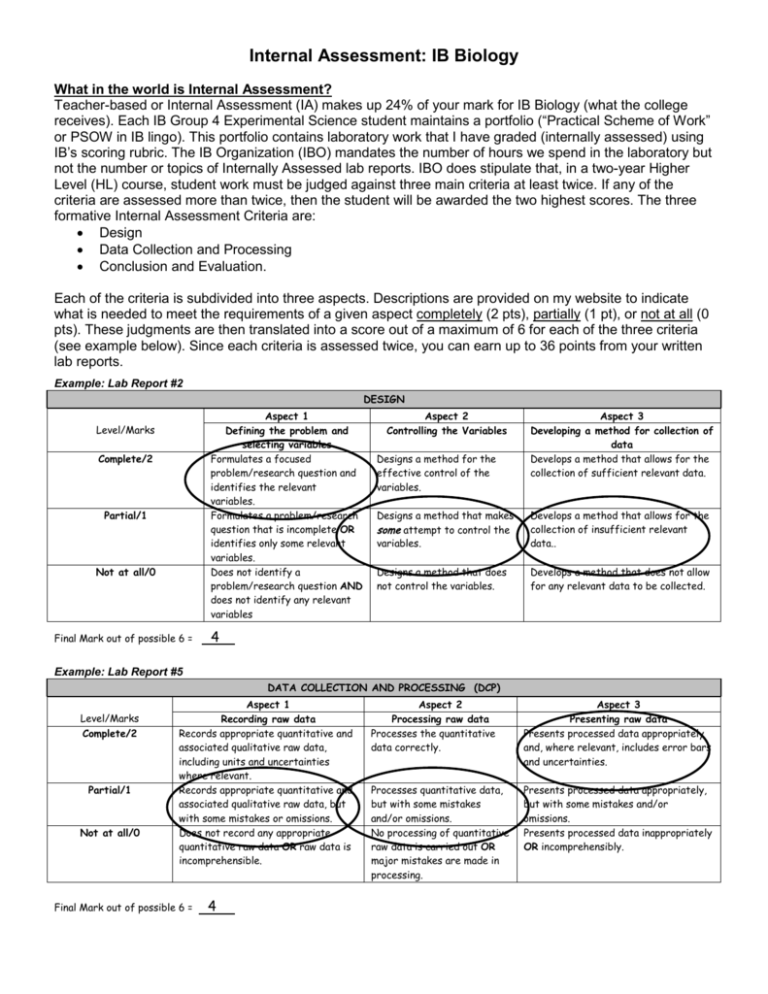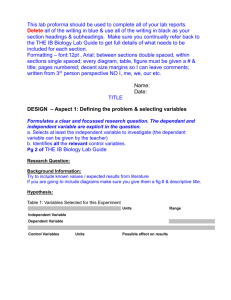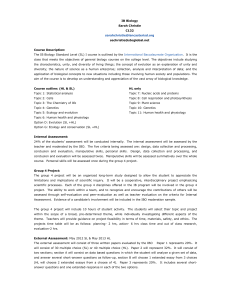Internal Assessment: IB Biology
advertisement

Internal Assessment: IB Biology What in the world is Internal Assessment? Teacher-based or Internal Assessment (IA) makes up 24% of your mark for IB Biology (what the college receives). Each IB Group 4 Experimental Science student maintains a portfolio (“Practical Scheme of Work” or PSOW in IB lingo). This portfolio contains laboratory work that I have graded (internally assessed) using IB’s scoring rubric. The IB Organization (IBO) mandates the number of hours we spend in the laboratory but not the number or topics of Internally Assessed lab reports. IBO does stipulate that, in a two-year Higher Level (HL) course, student work must be judged against three main criteria at least twice. If any of the criteria are assessed more than twice, then the student will be awarded the two highest scores. The three formative Internal Assessment Criteria are: • Design • Data Collection and Processing • Conclusion and Evaluation. Each of the criteria is subdivided into three aspects. Descriptions are provided on my website to indicate what is needed to meet the requirements of a given aspect completely (2 pts), partially (1 pt), or not at all (0 pts). These judgments are then translated into a score out of a maximum of 6 for each of the three criteria (see example below). Since each criteria is assessed twice, you can earn up to 36 points from your written lab reports. Example: Lab Report #2 DESIGN Aspect 1 Defining the problem and selecting variables Formulates a focused problem/research question and identifies the relevant variables. Formulates a problem/research question that is incomplete OR identifies only some relevant variables. Does not identify a problem/research question AND does not identify any relevant variables Level/Marks Complete/2 Partial/1 Not at all/0 Final Mark out of possible 6 = Aspect 2 Controlling the Variables Designs a method for the effective control of the variables. Aspect 3 Developing a method for collection of data Develops a method that allows for the collection of sufficient relevant data. Designs a method that makes some attempt to control the variables. Develops a method that allows for the collection of insufficient relevant data.. Designs a method that does not control the variables. Develops a method that does not allow for any relevant data to be collected. 4 Example: Lab Report #5 DATA COLLECTION AND PROCESSING (DCP) Level/Marks Complete/2 Partial/1 Not at all/0 Aspect 1 Recording raw data Records appropriate quantitative and associated qualitative raw data, including units and uncertainties where relevant. Records appropriate quantitative and associated qualitative raw data, but with some mistakes or omissions. Does not record any appropriate quantitative raw data OR raw data is incomprehensible. Final Mark out of possible 6 = 4 Aspect 2 Processing raw data Processes the quantitative data correctly. Aspect 3 Presenting raw data Presents processed data appropriately and, where relevant, includes error bars and uncertainties. Processes quantitative data, but with some mistakes and/or omissions. No processing of quantitative raw data is carried out OR major mistakes are made in processing. Presents processed data appropriately, but with some mistakes and/or omissions. Presents processed data inappropriately OR incomprehensibly. Example: Lab Report #5 CONCLUSION AND EVALUATION (CE) Level/Marks Complete/2 Partial/1 Not at all/0 Aspect 1 Concluding States a conclusion, with justification, based on a reasonable interpretation of the data. States a conclusion based on a reasonable interpretation of the data. States no conclusion OR the conclusion is based on an unreasonable interpretation of the data. Final Mark out of possible 6 = 5 Aspect 2 Evaluating Procedure(s) Evaluates weaknesses and limitations. Identifies some weaknesses and limitations, but the evaluation is weak or missing. Identifies irrelevant weaknesses and limitations. Aspect 3 Improving the Investigation Suggests realistic improvements in respect of identified weaknesses and limitations. Suggests only superficial improvements. Suggests unrealistic improvements. TOTAL: 13/18 Besides the three formative IA criteria, IBO asks teachers to judge student performance in two other areas: Manipulative Skills and Personal Skills. Each of these criteria can earn a maximum of 6 points bring your total possible IA score to 48 points. Remember, these 48 points are worth 24% of your overall IB score. Manipulative Skills are evaluated in the lab during experiments throughout the course and include such things as following instructions accurately, competency with lab equipment, and lab safety. Personal Skills are evaluated once during the independently conducted Group 4 Experiment in late winter. How do I write IB Laboratory Reports? Every time we do an experiment (as opposed to a paper activity), you will write a laboratory report. Follow the format on the handout titled: Honors/IB Biology Lab Report Format. Your report will be read and assessed on one or all three of the formative IA criteria. **Please write “Moderator Friendly” lab reports. This means: - type up the lab report; - no plastic jackets; - no pencil unless used for a sketch; - white paper; - single-sided; - affix added paper (such as a square of graph paper) to a report by taping around it on all four sides; - your complete IB number on the top right corner of every page. Because the IBO selects portfolios for moderation at a moment’s notice, portfolios MUST be maintained in ready-to-mail condition. At the latest, all portfolios will be completed and ready to mail off by the beginning of March. NOTE: All new content will be completed by early April. This will be followed by an intense review of as much material as possible in preparation of the exam (external assessment) in May. External Assessment: IB Biology What in the world is External Assessment? The External Assessment is the exam taken in May and it makes up 76% of your mark for IB Biology (what the college receives). What you need to study for this exam depends on whether you are taking the Standard Level (SL) exam or the Higher level exam (HL). If you are a full IB candidate, you will need to take 3 HL exams (the other 3 exams can be SL). Both Honors Biology (Year 1) and IB Biology (Year 2) are taught at the HL level. In order to help you decide which exam you should take, as well as to help you focus your studying in May, the differences between SL and HL are outlined below. The IB exam is broken into 3 “papers” or parts. Paper 1 is a multiple choice test which consists of either 30 (SL) or 45 (HL) questions. Paper 2 will be taken the same day as Paper 1 and in this part of the exam, you will be interpreting scientific data based on your knowledge of Biology (questions come from the “Topics” for your level- see below). The format for the answers is short answer or sketches with accompanying labels. Paper 3 will be taken the next day and will test your knowledge on two of the Options listed below (you will be given a choice as to which two you want to address). TOPICS SL and HL: Topic 1: Statistical Analysis Topic 2: Cells Topic 3: The Chemistry of Life Topic 4: Genetics Topic 5: Ecology & Evolution Topic 6: Human Health & Physiology OPTIONS SL only: Option A: Human Nutrition & Health Option B: Physiology of Exercise Option C: Cells & Energy HL only: Topic 7: Nucleic Acids & Proteins Topic 8: Cell Respiration & Photosynthesis Topic 9: Plant Science Topic 10: Genetics Topic 11: Human Health & Physiology SL and HL: Option D: Evolution Option E: Neurobiology & Behavior Option F: Microbes & Biotechnology Option G: Ecology & Conservation HL only: Option H: Further Human Physiol. As you can see, Year 1 of IB Biology (Honors Biology) is very important!! Do not wait to review these topics in May!! You may be taking several exams and as a result, study time becomes very precious and is never enough. Time management is going to be essential to your success! Also, when you allocate study time in May, you should focus on IB’s detailed syllabus. You can access this syllabus through my website: www.nphsscience.com (look under “resources”). For example, since you will not have time to study all the material for every option, focus on two you feel most comfortable with in order to prepare for Paper 3. NOTE: All students, regardless of whether they are SL or HL, will be expected to learn the material taught in this class. Class exams are not differentiated by level.








